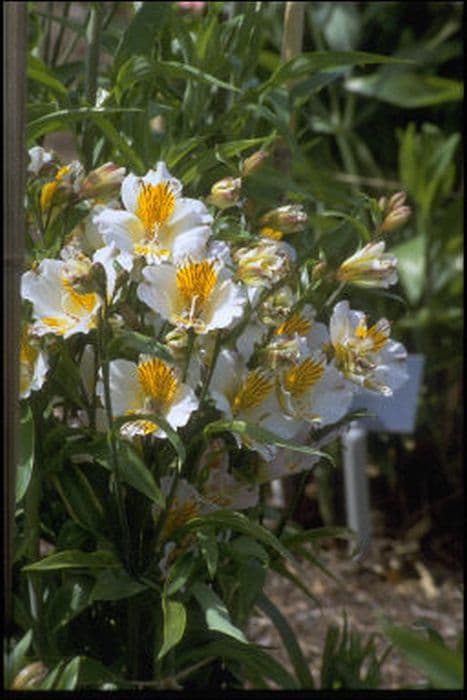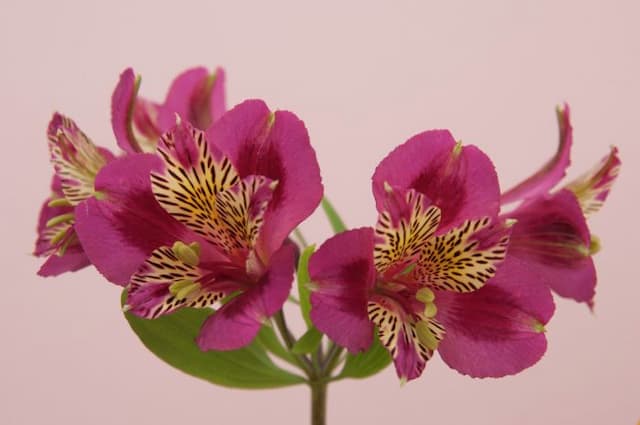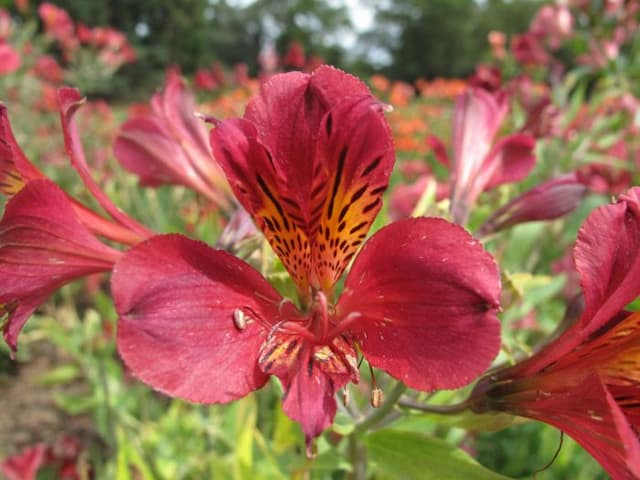Peruvian Lily Alstroemeria Princess Kate = 'Zaprikate' (PBR) (Princess Series)

ABOUT
The Alstroemeria Princess Kate, part of the Princess Series, is a stunning plant recognized for its striking flowers and elegant foliage. The blooms are particularly eye-catching with a harmonious blend of colors; the petals exhibit a blend of soft cream and pink hues with distinctive dark pink speckles. These petals are arranged in a lily-like fashion, radiating from the center of the flower, creating a delicate and exotic look. The leaves of Princess Kate add to the plant's beauty with their dense, green appearance. These leaves often have a twisted growth pattern, which adds a textural interest to the overall look of the plant. The contrast between the vibrant flowers and the lush green foliage makes the Alstroemeria Princess Kate a visually appealing addition to any garden. As a member of the Princess Series, this Alstroemeria is cultivated for its ornamental qualities, producing an abundance of flowers that are also known for their longevity, whether they adorn the plant or are cut for indoor arrangements. The overall aesthetic of the Alstroemeria Princess Kate is one of elegant charm and lively color, making it a captivating choice for gardeners looking to infuse their gardens with a touch of royalty.
About this plant
 Names
NamesFamily
Alstroemeriaceae
Synonyms
Peruvian Lily, Lily of the Incas, Parrot Lily
Common names
Alstroemeria 'Zaprikate'
 Toxicity
ToxicityTo humans
The Peruvian Lily is not considered highly toxic to humans. However, it can cause mild irritation when handled without gloves due to the presence of tulipalin, a skin-irritating compound. If ingested, parts of the plant may lead to gastrointestinal upset such as nausea or vomiting, but severe poisoning is rare.
To pets
The Peruvian Lily is mildly toxic to cats and dogs. If a pet consumes parts of the plant, it may experience symptoms such as vomiting, diarrhea, or abdominal pain. It is advisable to keep pets away from the plant and consult a veterinarian if ingestion occurs.
 Characteristics
CharacteristicsLife cycle
Perennials
Foliage type
Deciduous
Color of leaves
Green
Flower color
Mixed
Height
2 feet 4 inches (0.71 meters)
Spread
1 foot 8 inches (0.51 meters)
Plant type
Bulb
Hardiness zones
7
Native area
South America
Benefits
 General Benefits
General Benefits- Long-Lasting Blooms: Produces flowers that last up to two weeks when cut, making them excellent for bouquets and floral arrangements.
- Attractive Colour: Features unique two-toned flowers, typically with contrasting colours, which add vibrancy and interest to gardens and indoor displays.
- Perennial Growth: As a perennial, it will return year after year, reducing the need for annual replanting.
- Drought Tolerant: Once established, the plant has good drought tolerance, requiring less frequent watering than some other garden plants.
- Cold Hardy: Capable of withstanding cooler temperatures, making it suitable for a range of climates and extending its growing season.
- Low Maintenance: Requires minimal upkeep compared to other garden flowers, with no need for deadheading to promote continued blooming.
- Pollinator Friendly: Attracts bees, butterflies, and other beneficial insects, supporting local ecosystems.
 Medical Properties
Medical PropertiesThis plant is not used for medical purposes.
 Air-purifying Qualities
Air-purifying QualitiesThis plant is not specifically known for air purifying qualities.
 Other Uses
Other Uses- Photography Prop: Alstroemeria Princess Kate flowers add vibrant color and aesthetic appeal, making them excellent subjects or backdrops for macro and nature photography.
- Culinary Garnish: The petals of Alstroemeria Princess Kate are non-toxic and can be used to add a splash of color to salads or as an elegant garnish on desserts and cakes.
- Handmade Paper: Dried petals of Alstroemeria Princess Kate can be incorporated into handmade paper for a unique texture and floral appearance.
- Art Supplies: The petals can be used to create natural dyes for fabrics or for use in watercolor painting.
- Bath Bombs: Dried petals of the Alstroemeria Princess Kate can be mixed into bath bomb recipes for a touch of luxury and visual appeal in bath products.
- Craft Projects: Pressed flowers of Alstroemeria Princess Kate can be used in scrapbooking, card making, or other paper crafts.
- Bookmarks: Laminated Alstroemeria petals can be turned into unique and beautiful bookmarks.
- Table Confetti: When hosting a party or celebration, fresh or dried petals can be scattered on tables for an eco-friendly and attractive confetti option.
- Floral "Ice": Freeze petals of Alstroemeria Princess Kate in ice cubes for a decorative touch in punch bowls or in individual drinks at parties.
- Perfumery: Although not a common use, the subtle fragrance of Alstroemeria Princess Kate can be captured and used in homemade perfumes or scented sachets.
Interesting Facts
 Feng Shui
Feng ShuiThe Peruvian Lily is not used in Feng Shui practice.
 Zodiac Sign Compitability
Zodiac Sign CompitabilityThe Peruvian Lily is not used in astrology practice.
 Plant Symbolism
Plant Symbolism- Friendship: Alstroemeria, also known as the Peruvian lily or lily of the Incas, often symbolizes a strong bond between friends, due to its supportive and intertwining growth habits.
- Devotion: The plant's long-lasting blooms represent the enduring nature of devotion and the commitment to support loved ones through all of life's challenges.
- Wealth and Prosperity: With its abundant flowers and vibrant colors, the Alstroemeria is commonly associated with wealth and the aspiration for a prosperous life.
- Mutual Support: Similar to friendship, the intertwining stems suggest mutual support among peers, making it a popular gift to signify teamwork and cooperation.
- Fortune: The Alstroemeria is often given as a gift to wish someone good luck or to celebrate a fortunate event owing to the belief that it brings positive energy and luck.
- Achievement of Aspirations: The upward growth and upward-facing blooms of the Peruvian lily symbolize the striving towards one’s goals and the achievement of personal aspirations.
 Water
WaterPeruvian lilies, including the 'Princess Kate', need to be watered regularly to maintain evenly moist soil, especially during the growing season. These plants prefer not to dry out completely, so assess the soil moisture by feeling the top inch; if it's dry, it's time to water. During active growth in spring and summer, they typically require watering once or twice a week, but this frequency should be adjusted based on temperature, light, and humidity conditions. Each watering session should provide enough water to soak the soil thoroughly; this could mean using approximately 1-2 gallons for an outdoor plant, depending on its size and the soil type. During the winter months, reduce watering as the plant's growth slows down.
 Light
LightThe Peruvian lily thrives in bright, indirect light to partial sun. A spot that receives morning sunlight and shade in the afternoon is ideal as it protects the plant from the harsh midday sun. Avoid placing 'Princess Kate' in full shade, as this can lead to fewer blooms and leggy growth.
 Temperature
TemperaturePeruvian lilies like 'Princess Kate' prefer temperatures between 65 and 80 degrees Fahrenheit for optimal growth. They can tolerate a minimum temperature of around 40 degrees Fahrenheit, but frosts or freezing temperatures can be damaging. To ensure healthy growth and flowering, keep the plants in a location where the temperature does not drop below the minimum threshold.
 Pruning
PruningPrune Peruvian lilies to stimulate growth and maintain the plant's shape. Deadheading spent flowers encourages repeated blooming throughout the growing season. In late fall or early winter, after flowering has ceased, cut back the stems to ground level to encourage vigorous growth the following spring. Pruning can be performed as needed during the growing season to remove dead or yellowing leaves.
 Cleaning
CleaningAs needed
 Soil
SoilPeruvian Lily requires well-draining soil with a mix of sand, loam, and compost to ensure nutrients and good drainage. The ideal pH range for the Peruvian Lily is slightly acidic to neutral, between 6.5 and 7.0. A custom mix can be made by combining equal parts of potting soil, coarse sand, and peat or organic compost to enhance fertility and drainage.
 Repotting
RepottingPeruvian Lilies should be repotted every two to three years to refresh the soil and to accommodate the growing tuberous root system. However, they do not like to be disturbed often, so only repot when necessary and handle the roots with care during the process.
 Humidity & Misting
Humidity & MistingPeruvian Lily thrives in moderate to high humidity levels; aim for a humidity level around 40% to 60%. They can tolerate lower humidity levels, but consistent higher humidity supports their lush foliage and blooming.
 Suitable locations
Suitable locationsIndoor
Place in bright, indirect light and keep the soil moist.
Outdoor
Plant in partial sun, sheltered spot; enrich soil with compost.
Hardiness zone
7-10 USDA
 Life cycle
Life cycleAlstroemeria, commonly known as Peruvian lily or lily of the Incas, and specifically the Princess Kate variety, begins its life cycle as a rhizome, which once planted, develops roots and shoots. The shoots emerge from the soil and grow into sturdy stems, with lance-shaped leaves appearing as they mature. The plant enters the vegetative stage, where it focuses on leaf and stem growth, until it reaches the flowering stage, where buds form and open into the distinctive, colorful trumpet-shaped flowers. Following pollination, which can be done by insects or birds, the flowers will develop seed pods if conditions allow. As the growing season ends, the plant may enter a dormancy phase, where above-ground growth dies back, and the rhizome survives underground. When environmental conditions become favorable again, the cycle restarts, with the rhizome producing new shoots that grow into mature plants.
 Propogation
PropogationPropogation time
Spring-Early Summer
Alstroemeria, commonly known as Peruvian Lily or Lily of the Incas, can be propagated through division, which is the most popular method for this perennial plant. This process is typically done in spring or early fall. To propagate through division, carefully dig up the clump of tubers from the ground, making sure not to damage them. Then, gently pull apart the tubers, ensuring that each section has at least one growth point. Replant the divisions at the same depth they were growing previously, spacing them about 12 inches (roughly 30 centimeters) apart to allow for growth. Keep the soil consistently moist and wait for new shoots to emerge, indicating successful propagation.
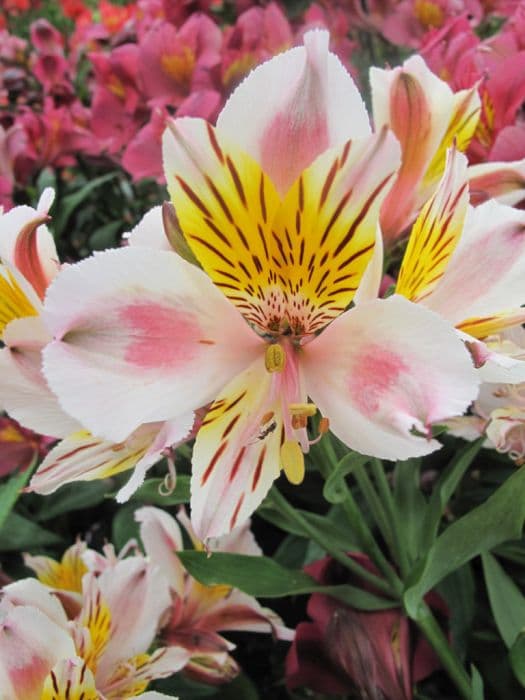
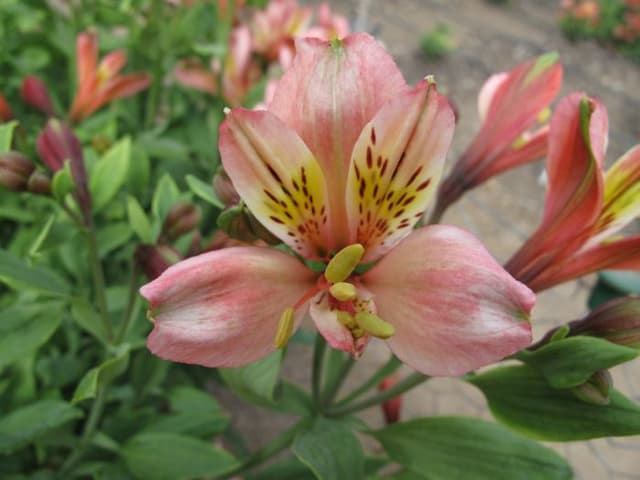
![Peruvian lily [Inca Glow]](/_next/image?url=https%3A%2F%2Fplants-admin.emdemapps.com%2Fimages%2Fplants%2F%2Fimages%2F604b5e99e48d9.png&w=640&q=75)
![Peruvian lily [Inca Smile]](/_next/image?url=https%3A%2F%2Fplants-admin.emdemapps.com%2Fimages%2Fplants%2F%2Fimages%2F604b5cad8fa91.png&w=640&q=75)
![Peruvian lily [Inticancha Passion]](/_next/image?url=https%3A%2F%2Fplants-admin.emdemapps.com%2Fimages%2Fplants%2F%2Fimages%2F604b5f7a78c8d.png&w=640&q=75)
![Peruvian lily [Summer Breeze]](/_next/image?url=https%3A%2F%2Fplants-admin.emdemapps.com%2Fimages%2Fplants%2F%2Fimages%2F604b6401573b7.png&w=640&q=75)

